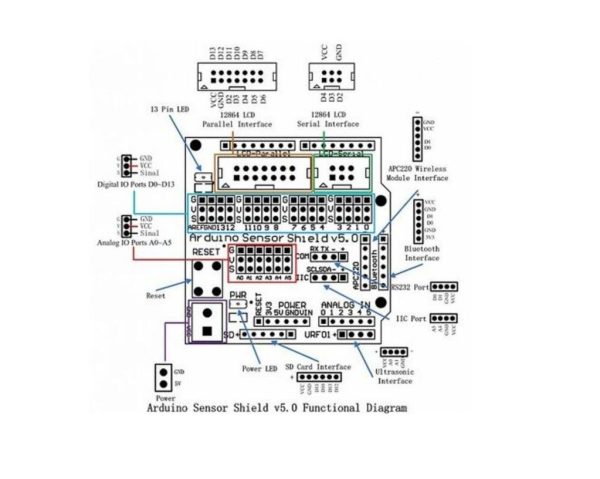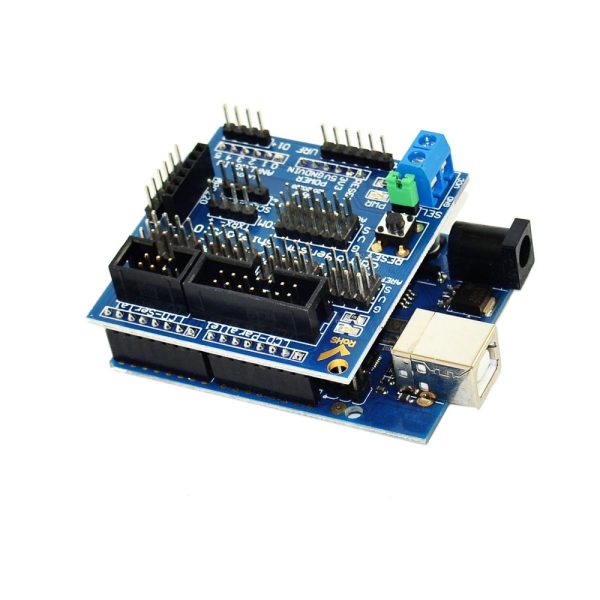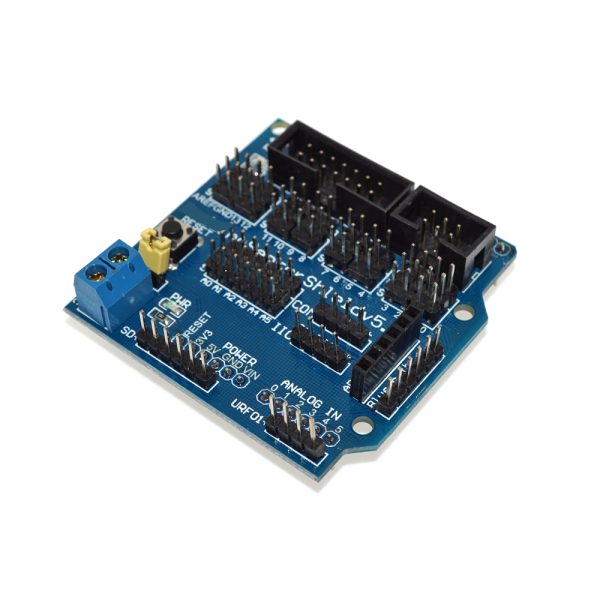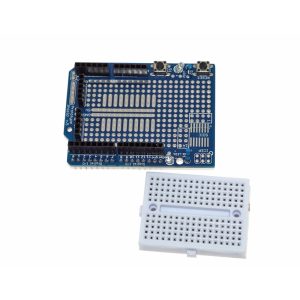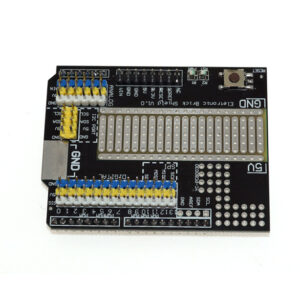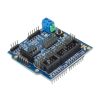UNO R3 Sensor Shield V5.0
The Arduino I/O Expansion Shield provides an easy way to connect sensors, servos and RS485 device to the Arduino board. It expands Arduino’s Digital I/O and Analog Input Pins with Power and GND
3 in stock

3 in stock
Description:
- UNO R3 Sensor Shield V5.0
- PIN13 LED Pilot
- Digital IO Ports D0-D13
- Analog IO Ports A0-A5
- Reset Button
- Power In
- Power LED
- SD Card Interface
- Ultrasonic Interface
- RS232 Interface(TTL)
- Bluetooth Interface
- APC220 Interface
- IIC Interface
- 12864 LCD Parallel Interface
- 12864 LCD Serial Interface
UNO R3 Sensor Shield V5.0 provides separate PWM Pins which are compatible with the standard servo connector. Another unique feature is that the I/O shield has a built-in RS485 converter which allows Arduino to communicate with RS485 devices. The communication socket provides an extremely easy way to plug a wireless module such as the APC220 RF module and DF-Bluetooth module. It has an individual power input for Servos. A servo power jumper allows the user to select using external power or internal power to drive the Servos.
What is Arduino Shield?
Arduino shields are the boards, which are plugged over the Arduino board to expand its functionalities.
For example, Ethernet shields are used to connect the Arduino board to the Internet. The pin position of the shields is similar to the Arduino boards.
Arduino
Arduino Uno SMD R3
Developer Arduino.cc
Manufacturer Arduino
Type Single-board microcontroller
Operating system None
CPU
- Atmel AVR (8-bit),
- ARM Cortex-M0+ (32-bit),
- ARM Cortex-M3 (32-bit),
- Intel Quark (x86) (32-bit)
Memory SRAM
Storage Flash, EEPROM
Arduino is an open-source hardware and software company, project and user community that designs and manufactures single-board microcontrollers and microcontroller kits for building digital devices. Its hardware products are licensed under a CC-BY-SA license, while the software is licensed under the GNU Lesser General Public License (LGPL) or the GNU General Public License (GPL), permitting the manufacture of Arduino boards and software distribution by anyone. Arduino boards are available commercially from the official website or through authorized distributors.
Arduino board designs
Use a variety of microprocessors and controllers. The boards are equipped with sets of digital and analogue input/output (I/O) pins that may be interfaced to various expansion boards (‘shields’) or breadboards (for prototyping) and other circuits. The boards feature serial communications interfaces, including Universal Serial Bus (USB) on some models, which are also used for loading programs. The microcontrollers can be programmed using the C and C++ programming languages, using a standard API which is also known as the “Arduino language”. In addition to using traditional compiler toolchains, the Arduino project provides an integrated development environment (IDE) and a command-line tool (Arduino-CLI) developed in Go.
What year did Arduino begin?
The Arduino project began in 2005 as a tool for students at the Interaction Design Institute Ivrea in Ivrea, Italy, aiming to provide a low-cost and easy way for novices and professionals to create devices that interact with their environment using sensors and actuators. Common examples of such devices intended for beginner hobbyists include simple robots, thermostats and motion detectors.
Where did the name come from?
The name Arduino comes from a bar in Ivrea, Italy, where some of the founders of the project used to meet. The bar was named after Arduin of Ivrea, who was the margrave of the March of Ivrea and King of Italy from 1002 to 1014.
Development Resources: demo codes, schematics, datasheets, etc
Reference for Arduino and reference to all matters.
Notes:
1. There may be slight size deviations due to manual measurement, different measuring methods and tools.
2. The picture may not reflect the actual colour of the item because of different photographing light, angle and display monitor.
Other Related Products
Components Package Kit for Arduino – 06
Components Package Kit for Arduino A low-cost components starter kit which comprises the most commonly used resistor values, potentiometers, switches, LED’s and Header terminal strips
| Weight | 0.028 kg |
|---|---|
| Dimensions | 7 × 6 × 2 cm |


